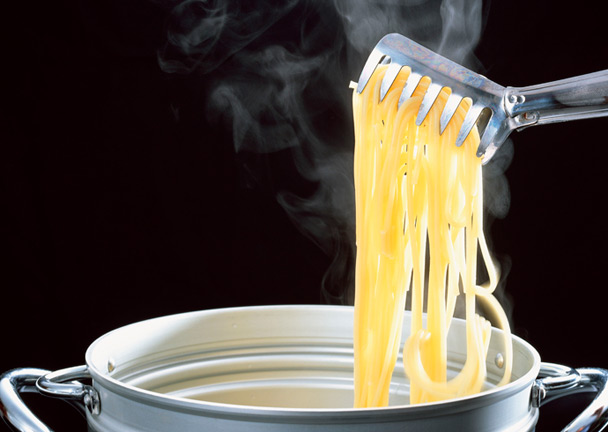
Of all the international cuisines America has welcomed to its kitchens, Italian food gets the warmest embrace. The single supermarket shelf of spaghetti, elbow macaroni, and German-style egg noodles I remember as a kid has given way to entire pasta aisles devoted to myriad brands—imported as well as domestic—and a dizzying variety of shapes, plus sauces to top them. Even homemade pasta, the subject of a separate primer in this issue, has become a pride and pastime of many. Yet in the grand scheme of anthropological time, the relatively few years it’s taken America to go from canned Spaghetti Os to artisanal garganelli would probably register as a nanosecond. So, as popular as pasta is, there’s still a fair amount we’ve yet to learn about it, and misconceptions abound. Here’s the real deal on preparing one of America’s favorite meals.
1. Fresh pasta is better than dried.
False
Unfortunately, food snobs have given fresh pasta a superiority complex, but no way is it better than dried. It’s simply that it’s made differently and tastes differently. In general, most fresh pastas include whole eggs or yolks, while most dried pastas are formed from just durum (meaning hard) wheat and water.
That said, there are plenty of exceptions: Fresh orecchiette is made with semolina (a form of durum wheat) and water—but no eggs. Conversely, some egg pastas are dried and sold alongside the durum wheat–and-water ones in the pasta aisle.
2. All dried pastas are pretty much the same.
False
Most of the dried pastas you see at the store are made from a simple wheat flour–and-water dough (pasta from Italy must, by law, use durum wheat). The dough is extruded by machines into different shapes. The best dried pastas—many of them from premium brands—are made from dough that’s been pushed through bronze dies, which leave the noodles with a slightly rough surface, giving the sauce something to hang onto. De Cecco is one widely available example; some brands indicate on their packaging or Web site if bronze dies have been used. By contrast, newer and cheaper Teflon-coated dies produce smoother, often shinier noodles that lack the cling factor.
3. Dried egg pasta is no different from wheat-flour pasta.
False
As myth #1 mentions, dried egg pastas can be found on supermarket shelves alongside the standard wheat-only variety. (These are not to be confused with traditional American egg noodles, which are actually of German heritage and are meant to be cooked until tender.) Dried fettuccine, for example, may turn up as a wheat-only noodle or enriched with egg (often twirled into nests and packed in wide, thin boxes). Expect a distinctive texture and mouth feel with egg pastas: They have a lighter, springier bounce to them, whereas durum wheat–and-water noodles tend to be heartier and chewier, even though both types should be cooked al dente.
Check the package weights for dried egg pasta and you’ll notice that most of them are in the 8- to 9-ounce range (vs. 16 ounces for the typical package of dried wheat pasta). That’s because pastas that contain egg expand significantly when cooked: For example, whereas a pound of dried (wheat) fettuccine serves four to six as a main, a half pound of dried egg fettuccine is plenty for four if not six (as always, depending on how filling the sauce is).
4. One pound of spaghetti = one pound of capellini.
False
It may sound logical that a pound of dried spaghetti, when cooked, would yield the same amount as a pound of dried capellini (a.k.a. angel hair). But have you ever noticed what a big pile of noodles you end up with when you cook a pound of capellini? That’s because capellini absorbs more water as it cooks and bulks up more than the same weight of spaghetti.
Why? Capellini has a greater surface area than spaghetti does, according to food scientist Shirley Corriher. And because the starch granules on pasta’s surface are the ones that absorb water most readily, capellini soaks up more water. Result: The cooked capellini will weigh more and fill you up sooner—so remember those deceptively skinny strands of angel hair when feeding a crowd on a budget.



 Pinterest
Pinterest


